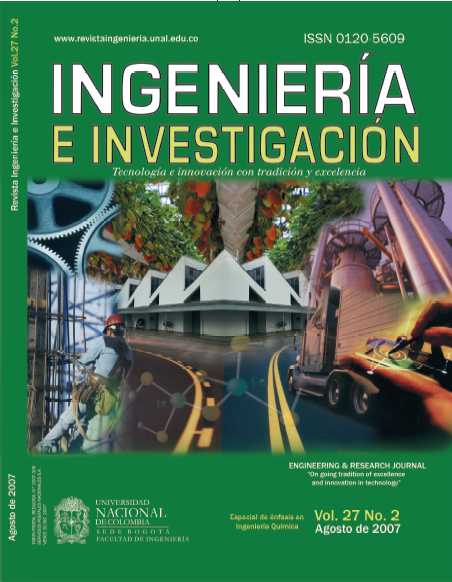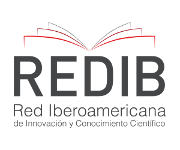Experimental determination of bagasse stiffness coefficient
Determinación experimental del coeficiente de rigidez del bagazo
DOI:
https://doi.org/10.15446/ing.investig.v27n2.14823Keywords:
stiffness coefficient, bagasse, compression rate (en)coeficiente de rigidez, bagazo, razón de compresión (es)
Downloads
The experimentally determined stiffness coefficient of bagasse is described in this paper. This property defines the behaviour of the reaction forces exerted upon the bagasse layer when being compressed during juice-extraction in a sugar-cane mill. This information is important for correctly analysing sugar-cane mill operation and design. An experimental device was used for obtaining the stiffness coefficient; it consisted of a piston, a piston-skirt, a hydraulic press and instrumentation for measuring the pressures so produced and piston position at different times. Compression rate, humidity level and degree of bagasse fragmentation were the experimental factors taken into account in the experimental design. The investigation was carried out with 40%-80% humidity level and up to 0.06 compression rates. All experimental factors proved statistically significant in the bagasse stiffness coefficient experimental model so obtained. Bagasse was seen to behave as a very rigid elastic material under normal sugar-mill pressure operating conditions, having 50 MPa to 20,000 MPa stiffness coefficient values.
En el artículo se determina experimentalmente el coeficiente de rigidez del bagazo comprimido. Esta propiedad define el comportamiento de la reacción que ejerce el colchón de bagazo a su paso por los molinos de caña de azúcar en el proceso de extracción de los jugos, siendo de importancia para un correcto análisis del funcionamiento y el diseño de los molinos. En la obtención del coeficiente de rigidez se empleó un dispositivo experimental compuesto por un pistón, camisa, prensa hidráulica e instrumentación para el registro de las presiones generadas, y la posición del pistón en función del tiempo. Los factores experimentales tenidos en cuenta en el diseño experimental son: relación de compresión, porcentaje de humedad y grado de fragmentación del bagazo. Se experimentó con un porcentaje de humedad entre el 40% y el 80%, y se alcanzaron relaciones de compresión de hasta 0,06. Se obtuvo un modelo experimental para el coeficiente de rigidez del bagazo donde todos los factores experimentales resultaron estadísticamente significativos. Se concluye que el bagazo se comporta como una fundación elástica muy rígida bajo las condiciones de presión existentes en un molino de caña, con valores del coeficiente de rigidez en el rango de 50 MPa a 20.000 MPa.
References
Arzola, N., Esquema de análisis para los árboles del molino de caña de azúcar y aplicación de la Mecánica de la Fractura en la evaluación de la falla por fatiga., tesis presentada a la Universidad Central de las Villas para optar al grado de Doctor en Ciencias Técnicas, CEDON, 2003.
Arzola, N., Goytisolo, R., Suárez, L. and Fernández, A., Efficiency increase in the extraction of sugar cane juice in the sugar cane mills by means of the regulation of hydraulic pressures., International Mechanical Engineering Congress & Exposition, ASME, Florida, USA, noviembre de 2005, pp. 1-5. DOI: https://doi.org/10.1115/IMECE2005-80439
Fernández, G. S., Investigación sobre el origen y desarrollo de la falla en árboles de molinos de centrales azucareros., tesis presentada a la Universidad Central de las Villas para optar al grado de Doctor en Ciencias Técnicas, UCLV, 1982.
Hugott, E., Manual para ingeniero Azucareros., México, Compañía Editorial Continental, S.A, 1988, pp. 803.
Jenkins, G. H., Introducción a la tecnología del azúcar de caña., La Habana, Editorial Ciencia y Técnica, 1987, pp. 568.
Pisarenko, G. S., Manual de Resistencia de Materiales., Moscú, Editorial MIR, 1985, pp. 695.
Satyanarayana, K., Methods of improving mill extraction., International Sugar Journal, Vol. 11, No. 4, 1986, pp. 9-11.
Shewale, P. K., Patil, A. R., Some aspects relating to reduction in the moisture content of bagasse by efficient milling operation., International Sugar Journal, Vol. 12, No. 9, 1987, pp. 9-11.
Shields, J. B., Some recent developments in sugar cane mills., International Sugar Journal, Vol. 10, No. 4, 1986, pp.8-12.
Veloz, Y., Esquema de análisis del Guijo Superior del Molino de Caña de Azúcar., Proyecto de Grado, Universidad de Cienfuegos, 1996.
How to Cite
APA
ACM
ACS
ABNT
Chicago
Harvard
IEEE
MLA
Turabian
Vancouver
Download Citation
CrossRef Cited-by
1. Salma O. M. Elshabrawy, Sherifa Elhady, Amal Elhussieny, Tania Dey, Irene Samy Fahim. (2024). Preparation and characterization of face masks made of bagasse, starch and chitosan obtained from agricultural and food wastes. Environmental Sustainability, 7(3), p.339. https://doi.org/10.1007/s42398-024-00320-0.
Dimensions
PlumX
Article abstract page views
Downloads
License
Copyright (c) 2007 Nelson Arzola de la Peña

This work is licensed under a Creative Commons Attribution 4.0 International License.
The authors or holders of the copyright for each article hereby confer exclusive, limited and free authorization on the Universidad Nacional de Colombia's journal Ingeniería e Investigación concerning the aforementioned article which, once it has been evaluated and approved, will be submitted for publication, in line with the following items:
1. The version which has been corrected according to the evaluators' suggestions will be remitted and it will be made clear whether the aforementioned article is an unedited document regarding which the rights to be authorized are held and total responsibility will be assumed by the authors for the content of the work being submitted to Ingeniería e Investigación, the Universidad Nacional de Colombia and third-parties;
2. The authorization conferred on the journal will come into force from the date on which it is included in the respective volume and issue of Ingeniería e Investigación in the Open Journal Systems and on the journal's main page (https://revistas.unal.edu.co/index.php/ingeinv), as well as in different databases and indices in which the publication is indexed;
3. The authors authorize the Universidad Nacional de Colombia's journal Ingeniería e Investigación to publish the document in whatever required format (printed, digital, electronic or whatsoever known or yet to be discovered form) and authorize Ingeniería e Investigación to include the work in any indices and/or search engines deemed necessary for promoting its diffusion;
4. The authors accept that such authorization is given free of charge and they, therefore, waive any right to receive remuneration from the publication, distribution, public communication and any use whatsoever referred to in the terms of this authorization.




























